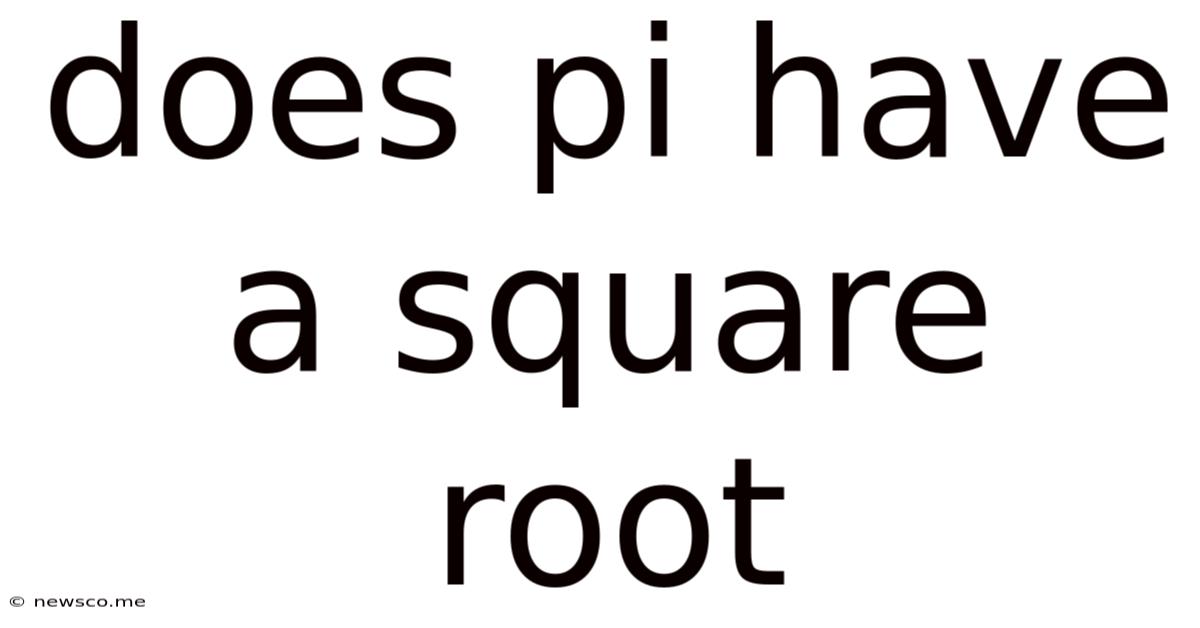Does Pi Have A Square Root
News Co
Mar 29, 2025 · 4 min read

Table of Contents
Does Pi Have a Square Root? Unraveling the Mysteries of Irrational Numbers
The question, "Does pi have a square root?" might seem simple at first glance. However, delving into this seemingly straightforward query reveals a fascinating journey into the realm of irrational numbers and the fundamental nature of mathematical constants. The short answer is yes, pi does have a square root, but understanding why requires a deeper understanding of what pi and square roots represent.
Understanding Pi (π)
Pi (π) is arguably the most famous mathematical constant. It represents the ratio of a circle's circumference to its diameter. This ratio is constant regardless of the circle's size. While often approximated as 3.14159, pi is an irrational number, meaning its decimal representation continues infinitely without repeating. This infinite, non-repeating nature is crucial to understanding its square root.
The Irrationality of Pi
The irrationality of pi was proven centuries ago, demonstrating that it cannot be expressed as a simple fraction of two integers (a/b). This inherent property has significant implications for its square root. It implies that pi, itself, cannot be perfectly represented by any finite decimal or fraction. The pursuit of calculating pi to ever greater precision has captivated mathematicians for millennia, leading to the development of sophisticated algorithms and computing power.
Exploring Square Roots
The square root of a number (√x) is a value that, when multiplied by itself, equals the original number (x). For example, the square root of 9 is 3 (because 3 x 3 = 9). While we can easily find the square roots of many numbers, calculating the square root of an irrational number like pi presents a unique challenge.
Square Roots of Irrational Numbers
The square root of an irrational number is also generally irrational. This is because if the square root of an irrational number were rational, its square (the original irrational number) would also have to be rational, creating a contradiction. Since pi is irrational, its square root must also be irrational, inheriting the infinite, non-repeating decimal nature of its parent number.
Calculating the Square Root of Pi
While we can't express the square root of pi as a neat fraction or a finite decimal, we can approximate it using various methods. The most common approach involves numerical methods such as the Babylonian method or Newton's method, which provide increasingly accurate approximations through iterative calculations.
These methods involve starting with an initial guess and repeatedly refining it using a specific formula until the desired level of accuracy is achieved. Modern computers can calculate the square root of pi to a remarkable number of decimal places, though the calculation will never reach a definitive end due to pi's irrationality.
The Approximate Value
The square root of pi (√π) is approximately 1.77245385091. This value, like pi itself, is only an approximation; the actual value extends infinitely without repeating. It's important to remember that this is just a truncated representation of an infinitely long decimal.
Implications and Applications
The square root of pi, while seemingly abstract, finds applications in various fields:
-
Geometry: It appears in calculations related to circles, spheres, and other curved shapes, particularly in formulas involving area and volume. For instance, the area of a circle is given by πr², and manipulating this formula can lead to expressions involving the square root of pi.
-
Probability and Statistics: Pi and its square root often emerge in probability distributions and statistical analyses, especially those involving normal distributions and related concepts.
-
Physics and Engineering: The square root of pi shows up in physical formulas, particularly those dealing with waves, oscillations, and diffusion processes.
-
Computer Science: Algorithms for numerical approximation and iterative calculations are crucial for computing the square root of pi to high precision.
Debunking Misconceptions
It's crucial to address some common misconceptions surrounding pi and its square root:
-
Pi is not equal to 3.14: 3.14 is a common approximation, but it is not the true value of pi. The decimal representation of pi continues infinitely.
-
The square root of pi is not a whole number: As an irrational number, the square root of pi cannot be expressed as a whole number or a simple fraction.
-
Calculating the square root of pi to infinite precision is impossible: Due to the infinite nature of pi, we can only approximate its square root. Any calculated value will be a finite approximation.
Conclusion: Embracing the Infinite
The question of whether pi has a square root leads to a deeper appreciation of the nature of irrational numbers. While we cannot obtain a precise, finite representation of √π, its existence is undeniable. The quest to understand and approximate this value showcases the power of mathematical tools and the enduring fascination with the infinite and the irrational. The pursuit of greater precision, whether through advanced algorithms or ever-increasing computing power, remains a testament to the boundless nature of mathematics itself. Ultimately, the exploration of pi and its square root underscores the beauty and complexity hidden within even the simplest mathematical concepts. The infinite, non-repeating nature of these values presents a captivating challenge, inspiring ongoing mathematical inquiry and exploration.
Latest Posts
Related Post
Thank you for visiting our website which covers about Does Pi Have A Square Root . We hope the information provided has been useful to you. Feel free to contact us if you have any questions or need further assistance. See you next time and don't miss to bookmark.